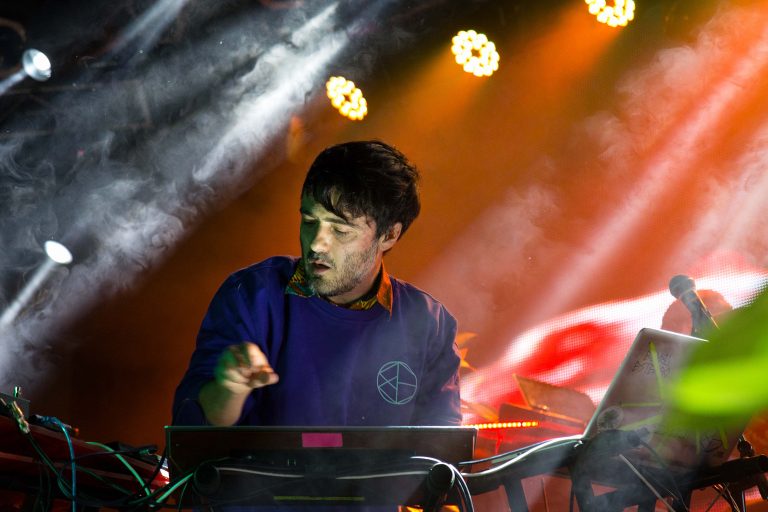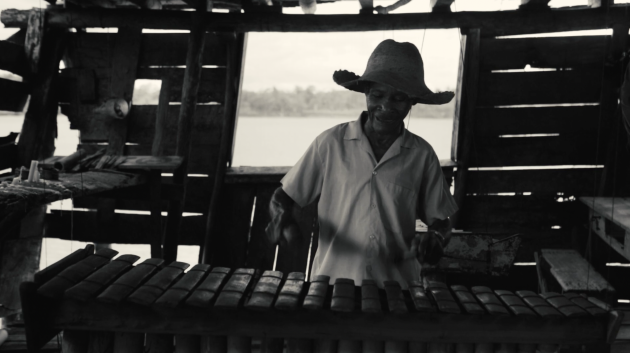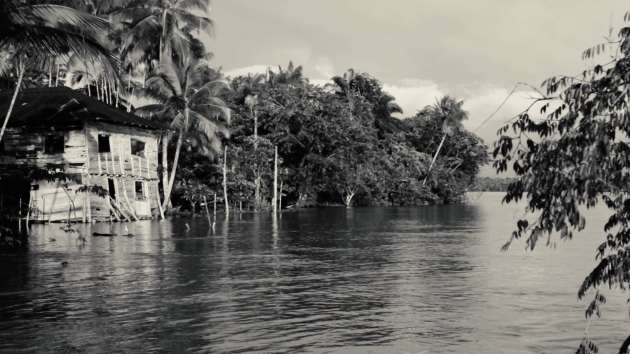
Bomba Estéreo’s Simón Mejía Ventures to the Pacific Coast to Discover Colombia’s Marimba Myths and Traditions
11 August, 2022El Duende is the latest project from Bomba Estereo’s Simón Mejía, which sees him working alongside Lucas Silva of Palenque Records, the highly esteemed record label focused on Afro-Colombian music. What started as an EP of remixes of tracks from the traditional marimba album, Los Duendes de la Marimba, with the renowned Dinastia Torres family in Guapi, then became something more. The EP is accompanied by a short documentary, that details the local Pacific myth of ‘El Duende,’ the creature that appears to aspiring marimberos. Part of a larger project, Stand For Trees, El Duende is one of many creations showcasing Mejía’s recent incentive to source artistic inspiration from those slightly more ‘untouched’ areas in Colombia.
We caught up with Simon to find out more about the project and how nature as a whole has had an impact on his work recently.
Where did the idea for this project come from? What was the initial process?
El Duende started as a musical project, actually as a remixes project. I have been very close friends with Lucas Silva from Palenque Records for many years. Palenque Records is a record label that has been doing research and recordings here in Colombia around Afro-Colombian music for many, many years.
He always wanted me to do remixes of the Pacific recordings he had. We spoke many, many years ago about making remixes and everything but I never had the time to do it. But then, during the pandemic, like everyone else, I had a lot more time. He sent me this beautiful record he did with Dinastia Torres. They are a family from Guapi that have carried this tradition of marimba playing through generations. Lucas Silva has been recording them for many years. Recently, he did this record with them that is called Los Duendes de la Marimba. He sent me that record and told me to just listen to the record and see if I would like to do some remixes. I was kind of new to Pacific music because in my career I have been more related to the Caribbean music of Colombia. That is very different from Pacific music. It is a different meter, the instrumentation is different, and the way of singing is different. But they come from the same root, this tradition of African and Indigenous folk music from Colombia.
So I started trying to understand and listen to the recordings and I started to experiment here in the studio with the marimba sounds and trying to understand how the rhythm works and everything. I started to do some tracks of what was going to be an EP of remixes.
While working through the music, I told Lucas that I wanted this record to not only be a remix record but to tell a story. I requested interviews that Lucas had done with the Torres family because I wanted to put those testimonies into the music. I wanted some context about it all. The next step was to put something visual to it. It was asking for something visual. Lucas started to send me visual material and I started to edit video clips and the music together. I started to put images on top of the remixes, in that kind of psychedelic way. Then I started working with a friend, Simón Hernández, and the project became a short film.
This project is very different from what you have been doing with Bomba Estéreo. What made you want to take a different direction?
I think in art when you are in an artistic process, that is different from an entertainment process. They both live together but I think they are two different processes. When you are more on the artistic side, the best thing is to keep on exploring and changing and reinventing and looking for new ways to express ideas through whatever media you like, whether it is writing, film-making, or painting. The moment you stop exploring is the moment that you die artistically. I’m not saying that I was dying with Bomba Estéreo, I love Bomba Estéreo. But that band has a recognised style that does very well. But my artistic mind needed more ways of expressing different things. I think each process feeds the other. My process with Bomba Estéreo feeds this process and vice versa.
Can you talk about the main theme of the project, ‘El Duende?’ What is this myth about?
El Duende is this myth in the Pacific Coast, a myth that I find very similar to the crossroads myth in blues music in North America. This crossroads myth is that guitar players in blues music arrive at a crossroads and there they meet with the devil. The devil then teaches them how to play the blues guitar. This duende myth here in Colombia is of the same essence. It’s about how the marimba players really have to know and understand how to play the marimba well. They have to go to the jungle, sit there and wait and this strange being comes. It is a mix between a devil and an elf. It comes and teaches them how to play and how to build the marimba. It’s a beautiful myth between fantasy and reality. The EP and the film are centered around the story of El Duende.
El Duende EP by Monte (Simón Mejía) and Dinastía Torres
Why was the visual aspect so important to you?
Because I think these kinds of places in Colombia, where this music happens, are very unique in the world. They are unique because of the nature that surrounds them. I think that here in Colombia, the folk music and the most outstanding folk music comes from outstanding natural spots. Not only in the Pacific but also in the Caribbean and in the Indigenous communities in the jungle too. It is because anciently, and actually still today, the inspiration of that music is nature. Where that music happens, nature is really strong. Whether it’s the Magdalena River, the Amazon Jungle, or the Pacific. If you are not from Colombia and you haven’t seen that, the only way to really understand it is to see it. Even if you see it in an image you won’t truly understand it. You have to go there and understand how the dynamic of life and how nature is the thing that dictates life and music there.
It is like transporting yourself centuries ago to where there are no roads. The highways are the rivers. Everything is connected by the rivers. That is really beautiful. When I was making the music I was thinking about how beautiful it is to think about this. It is a world and a memory of a world that perhaps in the future is going to disappear. Hopefully not. But who knows what will happen when they start building roads and connecting the Pacific with the rest of the country. We don’t know what’s going to happen. What is happening there today is unique. Having it registered in music and sounds is kind of a memory of that ancient and special world.

What is it about the Pacific, and nature in general, that is so inspirational for you?
I think it’s water. I think the richness of Colombia that we still are in the process of understanding is down to the water. It is a country of water. Water is what made the country. The rivers were what connects the country. It was what connected music as well. For example, on the Caribbean Coast, the Magdalena river was the one that connected the dots to make cumbia and the entire folk tradition there happen. Through the Magdalena river, the old African diaspora entered and the Spanish colonisation entered, and in a violent way, made the music happen after this. The Indigenous, African and Spanish encounters happened.
When you listen to the lyrics of folk music they are always referencing nature. So nature, here in Colombia is very powerful. It is the inspiration for them and obviously for me. But me, being a person that lives in the city, has to go to those places to understand the power of nature. You have to feel it in the mornings and in the sunsets and understand … just to be there to get that feeling.
El Duende is part of a much larger project you are working on, Stand For Trees. How important is it to you to promote discussions around the environment?
It is really important to me because I feel that as Colombians and as South Americans this is what we have to fight for but it is the richness we have. You know, in Latin America, and in Colombia in particular, we are a really powerful country in terms of nature. We don’t have a huge industrial development or silicon valley or a really strong bank system or whatever… but we have nature. And that is our future actually.
As an artist, I understand that the most powerful music that we have in Colombia comes from nature. It became a responsibility for me to make that visible and fight to protect it. If there is no nature, no rivers or jungles, there won’t be more music. We will not have our roots in music. It is a musical fight as well. We have treasures here to protect in Colombia and I think that is my mission in life.
There has been a huge movement of musicians in Colombia searching for this roots music you talk about…
This awareness has been happening for the last 10 or 20 years in Colombia, that our traditional music is really strong. Before that, we didn’t have this notion. It is very recent. We were always looking outside. English-speaking music coming from the states or Europe has always been the strongest. We were trying to imitate that. But we are not that. We are from Colombia and here in Colombia we have this fusion, we are not a unique race, we are a mix of races, of Indigenous, Black, White, whatever. Being a mixed race means we just mix music. And look at where our roots come from, understand that, and try to incorporate it into this global language. It is being faithful where we come from. To try and show the world something different, not an imitation.

So what is it about El Duende that helps to show the world something different from Colombia?
I think with El Duende, and other things in Pacific Culture, are more surreal. Time works at a different rhythm than we understand. The space is different. Human relations are different. Everything is really different. I find it really surreal. El Duende is kind of a fantasy story. With the film, we tried to bring this surrealism, but bring that psychedelic aspect to it, and just let them (Torres Family) take the narrative. Let them speak and we try to enter into their world without imposing anything.
What do you hope that people take away from El Duende (the documentary and EP)?
Hopefully, they can understand a bit more about the Pacific Coast of Colombia. But especially, what I would love most about this project is that it is a kind of a memory of an ancient era, of ancient times. Because, today in modern times, it is really rare to see these kinds of stories and these kinds of people living in these places. There are no roads, communication is difficult and you don’t get the internet so easily. These are really isolated places. But, being isolated makes them great. The Pacific Coast of Colombia, being an isolated place from the rest of Colombia, with all the problems that this can cause for the people there, but in terms of culture and nature, it makes it unique. It makes it kind of frozen in time to have these types of stories that for me are like the stories you used to listen to when you were a kid. These jungle myths and those that are in the territory of fantasy are so rare to hear today. Having all of this on tape and film is a memory of that world that we don’t know if in the future it will still be here. It’s very poetic for me. The people there and their way of living are really beautiful and poetic as well.
Are there plans in the future to do more projects like this?
Yes. I would love to do a feature film. One that would be half fiction, half documentary. Yeah, I would love to do that, related to music and everything. That’s one of my dreams.
You can watch El Duende in its entirety below:
Follow Sounds and Colours: Facebook / Twitter / Instagram / Mixcloud / Soundcloud / Bandcamp
Subscribe to the Sounds and Colours Newsletter for regular updates, news and competitions bringing the best of Latin American culture direct to your Inbox.

